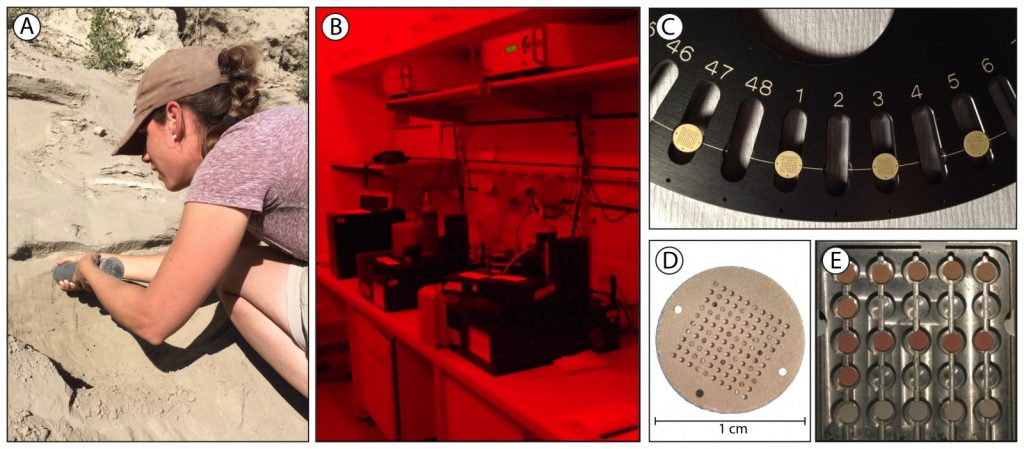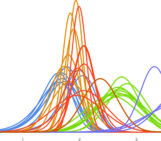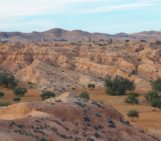
The last 2.5 Million years of the Earth’s history (termed Quaternary) are characterised by climatic cycles oscillating between warm (interglacial) and cold (glacial) periods. To be able to fully understand and interpret past climate variations the development of accurate and precise chronological techniques is crucial. Optically stimulated luminescence (OSL) dating is a strong geochronological tool that can be used to date across a wide time range, from the modern days to a few hundred thousand years ago. It has been used to date sediments in nearly all parts of the world. The event that is being dated is the last time the sediment has been exposed to daylight, which means that the luminescence age is directly related to the time of sediment deposition.
How does OSL work?
OSL dating is based on the ability of minerals to store energy (Preusser et al., 2008). Luckily quartz and feldspar, the two most common minerals in the Earth’s crust have this ability. They work like small batteries, which get charged when the sediment is buried (Fig. 1 C, Duller, 2008). This is due to radiation from naturally occurring radioactive material (uranium, thorium and potassium) in the surrounding sediment, and from cosmic rays for samples closer to the surface. Like a battery, the quartz and feldspar grains have a finite capacity for storing energy. Once completely charged, the battery-like grain is considered as being saturated. This upper age limit of OSL dating depends on the ability of the grain to store the energy and on the rate at which the grain is charged (i.e. the dose rate, derived from uranium, thorium, potassium and cosmic radiation). If the surrounding material is very radioactive, the dose rate is very high, which means that the grain saturates rather quickly (Fig. 1C), but if the dose rate is low, the battery-like grain charges more slowly and OSL can be used to date geomorphological processes further back in time. Exposure to natural sunlight will remove charge from the grain. This bleaching or resetting occurs e.g. during sediment transport and deposition (Fig. 1A, D). Subsequently, the sediment can be buried again and the grain will get charged (Fig. 1D) until it is saturated, or until the sediment is transported and re-deposited, or is sampled (Fig. 1F). Once sampled in opaque tubes (Fig. 2 A), so that no daylight can affect the amount of energy stored in the grains, the sample is ready to be processed in the laboratory.

Figure 1: . Accumulation and release of charge within mineral grains (modified from Duller, 2008). (A) During transport of sediment the accumulated charge gets released due to energy provided by natural sunlight; (B) At deposition, the charge is fully released and the “battery” is emptied; (C) Charge can accumulate within the grain during burial due to natural ionising radiation; (D) and (E) The process described before can happen multiple times over geological times scales, depending on the environment and the geological processes; (F) When a sample is taken in opaque tubes or using cores the stored energy at that particular time gets sampled and can later be released in the laboratory to obtain a luminescence age.
What happens in the laboratory?
Sample preparation involves multiple steps to isolate the right minerals and grain size for dating. A key step is the decision on the mineral that will be used for dating. Whilst quartz gets reset more quickly when exposed to sunlight, feldspar has the potential of dating events further back in time.
The energy stored in the mineral grains cannot only be released by natural sunlight, but also in the laboratory using a defined wavelength under controlled conditions (Fig. 2B). During this process, the grain emits light, which is collected. This emitted light gives information on the amount of stored energy (Duller et al., 2008; Preusser et al., 2008). When comparing this light output, from a natural radiation dose received, to a light output generated by a known laboratory dose, the so-called laboratory equivalent dose is obtained. This equivalent dose (in Gy), divided by the natural dose rate (in Gy/1,000 years) will give the OSL age in thousand years (Duller et al., 2008; Preusser et al., 2008). OSL dating can be done using different grain sizes of sediment, either mounted as patches of grains on aluminium or steel discs (Fig. 2E) or as single grains, brushed into very small holes on a disc (Fig. 2C, D). As an alternative to grains, slices of rock can be used (e.g. Sohbati et al., 2011; Jenkins et al., 2018). Important is a representative number of sub-samples, which will be analysed using statistical means to get a valid age (Galbraith et al., 1999; Galbraith and Roberts, 2012).

Figure 2: (A) Sampling of sediment in an opaque tube for OSL dating; (B) Luminescence instruments (here Risø Readers) used to date the samples. The picture also shows the photographic read light conditions under which samples are prepared and measured to avoid resetting of the battery-like grains; (C) Sample carousel with single grain discs; (D) Close-up of a single grain discs containing grains in 100 holes (300 µm in diameter); (E) Steel discs containing fine silt size material (4-11 µm). Credit photos: (A) H. M. Roberts, (B)-(D) S. Riedesel, (E) A. M. Zander.
Where can and has OSL dating been applied? –Some examples from past climate research
Luminescence dating can be a valuable geochronological tool in very different climatic parts of the Earth: the terrestrial systems with loess and lake records for example, the glacial land system, with a focus on ice marginal archives and the deep marine archives with long sedimentary records.
Terrestrial archives – loess and lakes
Loess is silt-size (4-63 μm) sediment transported by wind (aeolian transport), which has been exposed to sufficient daylight to fully reset the stored luminescence signal. This makes it favourable for luminescence dating. The Chinese Loess Plateau (CLP) is the Earth’s most important terrestrial climate archive. Changes in the accumulation of loess and/or the occurrence of soil horizons within the loess sequences, give information on changes in past climate (e.g. temperature, wind direction and intensity, precipitation). For a long time it has been considered as a continuous past climate archive (Liu and Ding, 1998). High-resolution OSL dating at different sites across the CLP gave new insights. It showed that the loess record is neither homogenous nor continuous (Stevens et al., 2007; Stevens et al., 2018). Unconformities could be detected and related to erosional processes, disturbances or diagenetic modifications (Roberts et al., 2001; Stevens et al., 2007; Buylaert et al., 2008). The application of OSL dating to loess has also helped to gain knowledge on e.g. variations in wind directions in the past (e.g. the East Asian Monsoon behaviour; Stevens et al., 2006; Kang et al., 2018).
Lake sediments also provide long records of past climate changes. Lamb et al. (2018) established a chronology based on a combination of OSL and radiocarbon dates for the past 150,000 years of Lake Tana in Ethiopia. This chronology helped to infer time spans of favourable climatic conditions for early human migrations. Another example is the late Quaternary chronology of the Xingkai Lake in northeast Asia by Long et al. (2015). It spans the past 130,000 years and shows how important independent age control is when performing geochronological research. The combination of OSL and radiocarbon ages highlights the potential of OSL to date events beyond the age range of radiocarbon (ca. 45,000 years, Walker, 2005).
Remnants of former lakes can also be used as archives, e.g. the beach ridges, marking former shorelines of palaeo-lake systems in the present day Kalahari Desert, bear witness to a wetter climate in the past (Burrough et al., 2009). OSL has been the key tool to establish a 280,000 year chronology of these palaeo-lake high-stands, giving insights into late Quaternary changes between arid and humid phases in southern Africa (Burrough et al., 2009).
The deep sea – Potential and challenges of these long records using OSL
In marine sediments, OSL dating can be used in addition to radiocarbon dating, or to date beyond the range of the latter (Stokes et al., 2003; Olley et al., 2004, Armitage and Pinder, 2017), or where insufficient biogenic carbonate is available. As radiocarbon dating of material in marine sediments can suffer from a reservoir age induced by old carbon in marine water, OSL dating can be a useful alternative (Olley et al., 2004). However, OSL dating of marine sediments can be challenging, since transport and deposition of the sediment under water complicates the bleaching of the sediment grains (Olley et al., 2004, Armitage and Pinder, 2017). Nevertheless, successful OSL research has been conducted in deep-sea environments. For example, Sugisaki et al. (2010) were able to establish an OSL-chronology of sediments from the Okhotsk Sea, including the last glacial-interglacial transition by covering a time span from 140,000 to 15,000 years.
Glacial land forms – Ice marginal features: What can they tell us about glacial advance and retreat?
OSL dating can be used in the cryosphere, e.g. to date relics of past glaciations. Smedley et al. (2016) used single grains of feldspar to date glacial advances during the last glacial maximum (LGM) in Patagonia. While their results for glacial advances at the onset of and during the LGM correlate with other studies in South America, the final glacial advance in their study area at ~15,000 years is later than elsewhere, which may hint towards local topographic and regional climatic factors (precipitation), controlling glacial responses, or preservation issues elsewhere.
The recent development of dating cobbles in glacial contexts not only enables the age determination of glacial features, such as glaciofluvial sediments, it also gives further insights into the transport history of the cobbles prior to their burial (Freiesleben et al., 2015; Jenkins et al., 2018). Cobbles can record the deposition event in a similar way to the one described above for much finer grained sediment. The great advantage of cobbles is their potential to record multiple exposure events (Freiesleben et al., 2015). In the case of a cobble from the Isle of Man, it potentially records the advance and retreat of the Irish Sea Ice Stream (Jenkins et al., 2018).
The examples presented here show the wide applicability of OSL dating to directly date the last exposure of sediment to daylight in various environmental settings. OSL techniques are able to date geological events beyond the age range of radiocarbon and recent developments improve the reliability of OSL dating in geomorphological settings, where resetting of the stored charge might otherwise be challenging.
This post has been edited by the editorial board.
References Armitage, S. J., Pinder, R. C., 2017. Testing the applicability of optically stimulated luminescence dating to Ocean Drilling Program cores. Quaternary Geochronology 39, 124-130. Burrough, S. L., Thomas, D. S. G., Bailey, R. M., 2009. Mega-Lake in the Kalahari: A Late Pleistocene record of the Palaeolake Makgadikgadi system. Quaternary Science Reviews 28, 1392-1411. Buylaert, J.-P., Murray, A. S., Vandenberghe, D., Vriend, M., De Corte, F., Van den haute, P., 2008. Optical dating of Chinese loess using sand-sized quartz: Establishing a time frame for Late Pleistocene climate changes in the western part of the Chinese Loess Plateau. Quaternary Geochronology 3, 99-113. Duller, G. A. T., 2008. Luminescence dating – Guidelines on using luminescence dating in archaeology. English Heritage, 44p. Freiesleben, T., Sohbati, R., Murray, A. S., Jain, M., al Khasawneh, S., Hvidt, Jakobsen, B., 2015. Mathematical model quatifies multiple daylight exposure and burial events for rock surfaces using luminescence dating. Radiation Measurements 81, 16-22. Galbraith, R. F., Roberts, R. G., 2012. Statistical aspects of equivalent dose and error calculation and display in OSL dating: An overview and some recommendations. Quaternary Geochronology 11, 1-27. Galbraith, R. F., Roberts, R. G., Laslett, G. M., Yoshida, H., Olley, J. M., 1999. Optical dating of single and multiple grains of quartz from Jinmium Rock Shelter, Northern Australia: Part 1, experimental design and statistical models. Archaeometry 41 (2), 339-364. Jenkins, G. T. H., Duller, G. A. T., Roberts, H. M., Chiverrell, R. C., Glasser, N. F., 2018. A new approach for luminescence dating glaciofluvial deposits – High precision optical dating of cobbles. Quaternary Science Reviews 192, 263-273. Kang, S., Wang, X., Roberts, H. M., Duller, G. A. T., Cheng, P., Lu, Y., An, Z., 2018. Late Holocene anti-phase change in the East Asian summer and winter monsoons. Quaternary Science Reviews 188, 28-36. Lamb, H. F., Bates, R., Bryant, C. L., Davies, S. J., Huws, D. G., Marshall, M. H., Roberts, H. M., 2018. 150,000-year palaeoclimate record from northern Ethiopia supports early, multiple dispersals of modern humans from Africa. Scientific Reports 8:1077. Liu, T., Ding, Z., 1998. Chinese loess and the paleomonsoon: Annual Review of Earth and Planetary Science 26, 111-145. Long, H., Shen, J., Wang, Y., Gao, L., Frechen, M., 2015. High-resoltuion OSL dating of a late Quaternary sequence from Xingkai Lake (NE Asia): Chronological challenge of the “MIS 3a Mega-paleolake” hypothesis in China. Earth and Planetary Science Letters 428, 281-292. Olley, J. M., De Deckker, P., Roberts, R. G., Fifield, L K., Yoshida, H., Hancock, G., 2004. Optical dating of deep-sea sediments using single grains of quartz: a comparison with radiocarbon. Sedimentary Geology 169, 175-189. Preusser, F., Degering, D., Fuchs, M., Hilgers, A., Kadereit, A., Klasen, N., Krbetschek, M., Richter, D., Spencer, J. Q. G., 2008. Luminescence dating: basics, methods and applications. Eiszeitalter und Gegenwart – Quaternary Science Journal 57 (1-2), 95-149. Roberts, H. M., Wintle, A., Maher, B. A., Hu, M., 2001.Holocene sediment-accumulation rates in the western Loess Plateau, China, and a 2500-year record of agricultural activity, revealed by OSL dating. The Holocene 11 (4), 477-483. Smedley, R. K., Glasser, N. F., Duller, G. A. T., 2016. Luminescence dating of glacial advances at Lago Buenos Aires (~46° S), Patagonia. Quaternary Science Reviews 134, 59-73. Sohbati, R., Murray, A. S., Jain, M., Buylaert, J.-P., Thomsen, K. J., 2011. Investigating the resetting of OSL signals in rock surfaces. Geochronometria 38 (3), 249-258. Stevens, T., Buylaert, J.-P., Thiel, C., Újvári, G., Yi, S., Murray, A. S., Frechen, M., Lu, H., 2018. Ice-volume-forced erosion of the Chinese Loess Plateau global Quaternary stratotype site. Nature Communications 9:983. Stevens, T., Thomas, D. S. G., Armitage, S. J., Lunn, H. R., Lu, H., 2007. Reinterpreting climate proxy records from late Quaternary Chinese loess: A detailed OSL investigation. Earth-Science Reviews 80, 111-136. Stevens, T., Armitage, S., Lu, H., Thomas, D. S. G., 2006. Sedimentation and diagenesis of Chinese loess: Implications for the preservation of continuous, high-resolution climate records. Stokes, S., Ingram, S., Aitken, M. J., Sirocko, F., Anderson, R., Leuschner, D., 2003. Alternative chronologies for Late Quaternary (Last Interglacial-Holocene) deep sea sediments via optical dating of silt-sized quartz. Quaternary Science Reviews 22, 925-941. Sugisaki, S., Buylaert, J.-P., Murray, A. S., Tsukamoto, S., Nogi, Y., Miura, H., Sakai, S., Iijima, K., Sakamoto, T., 2010. High resolution OSL dating back to MIS 5e in the central Sea of Okhotsk. Quaternary Geochronology 5, 293-298. Walker, M., 2005. Quaternary Dating Methods. John Wiley and Sons, Chicchester, United Kingdom, 307 p.




